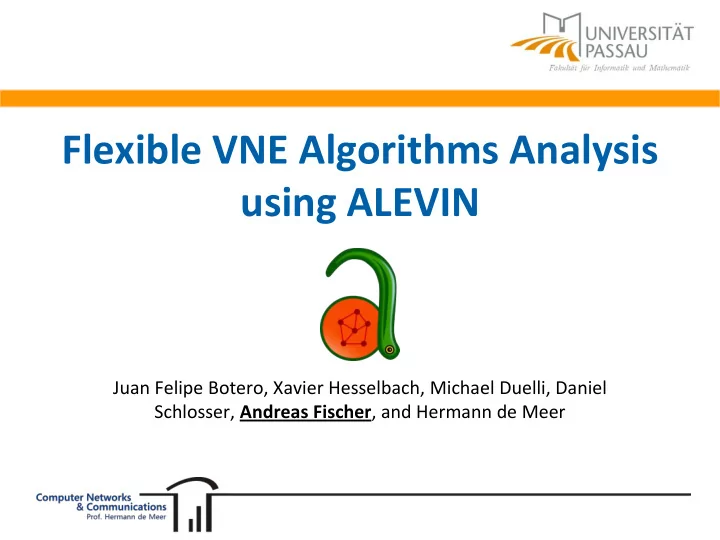

Flexible VNE Algorithms Analysis using ALEVIN Juan Felipe Botero, Xavier Hesselbach, Michael Duelli, Daniel Schlosser, Andreas Fischer , and Hermann de Meer
Problem description Virtual Network Embedding (VNE): Map virtual resources to substrate resources Substrate network provides resources Virtual networks consume resources EuroView2011: Flexible VNE Algorithms Analyis - A. Fischer 2
Constraints & Problem complexity Embedding is NP-complete Bin-packing problem (nodes) Unsplittable Flow problem (links) Different heuristics implemented in algorithms EuroView2011: Flexible VNE Algorithms Analyis - A. Fischer 3
Optimization metrics Different ways to optimize VNE Minimize cost/revenue ratio Cost: Physical resources that have to be spent Revenue: Virtual resources that can be mapped Maximize acceptance ratio of virtual networks Take additional effects into account Hidden hops: Traffic forwarding costs resources as well How to evaluate? VNE simulation framework: ALEVIN (http://alevin.sf.net/) EuroView2011: Flexible VNE Algorithms Analyis - A. Fischer 4
Evaluation: Cost-revenue Scenario parameters: • 50 substrate nodes • 15 Virtual Networks • 20 nodes per VN • Link resources: 0-100 • Node resources: 0-100 EuroView2011: Flexible VNE Algorithms Analyis - A. Fischer 5
Evaluation: Virtual Network acceptance ratio Scenario parameters: • 50 substrate nodes • 15 Virtual Networks • 20 nodes per VN • Link resources: 0-100 • Node resources: 0-100 EuroView2011: Flexible VNE Algorithms Analyis - A. Fischer 6
Conclusions and Future Work Conclusions ALEVIN provides framework to compare VNE algorithms Additional constraints (hidden hops) influence algorithms Further analysis is needed Future Work Optimize embedding with regard to other goals Energy consumption Security / Resilience Investigate application to large test-bed scenarios EuroView2011: Flexible VNE Algorithms Analyis - A. Fischer 7
Recommend
More recommend